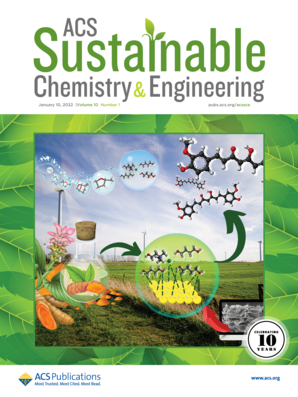基于PET酶解聚合的PET- pe多层包装材料的高效回收
IF 7.3
1区 化学
Q1 CHEMISTRY, MULTIDISCIPLINARY
引用次数: 0
摘要
向可持续循环经济的过渡需要将更多的塑料废物回收利用成高质量的再生塑料。然而,利用现有的机械回收技术回收混合废物馏分或普通多层材料是一个挑战。由于酶解条件温和,具有选择性,因此有可能提供一种解决方案。在本研究中,我们证明聚酯水解酶可以用于回收PET-PE多层包装废弃物,而无需昂贵的非晶化预处理。利用重组毕赤酵母制备聚酯水解酶,对PET- pe多层托盘中的PET层进行高效解聚。在实验室规模下,未经纯化的酶和高PET- pe负载(10-20% w/w PET- pe, PET解聚≥94%,对苯二甲酸回收率≥80%)获得了高收率。酶促反应扩大到4.5公斤PET-PE生产废料。解聚后(PET解聚≥95%),分离对苯二甲酸,再聚合成rPET。回收剩余的PE层,用碱性清洗步骤去除残留的PET污染,并成功地再加工成具有与原始低密度PE相似性能的rPE膜。这项研究证明了酶解对PET-PE多层材料回收的适用性,并强调了它在混合消费后废物中回收聚酯的一般潜力。本文章由计算机程序翻译,如有差异,请以英文原文为准。

Efficient Recycling of PET-PE Multilayer Packaging Materials Based on Enzymatic Depolymerization of PET
The transition to a sustainable, circular economy requires more plastic waste to be recycled into high-quality recycled plastics. However, it is challenging to recycle mixed waste fractions or common multilayer materials by using current mechanical recycling technology. Enzymatic hydrolysis potentially offers a solution because of its mild conditions and selectivity. In this study, we show that polyester hydrolases can be applied to recycle PET-PE multilayer packaging waste without costly amorphization pretreatment. Polyester hydrolases were produced by recombinant Pichia pastoris yeast and used to efficiently depolymerize the PET layer of PET-PE multilayer trays. High yields were obtained at laboratory scale with unpurified enzyme and high PET-PE loading (10–20% w/w PET-PE, ≥94% PET depolymerization, and ≥80% terephthalic acid recovery). The enzymatic reaction was scaled up to 4.5 kg of PET-PE production waste. After depolymerization (≥95% PET depolymerized), terephthalic acid was isolated and repolymerized into rPET. The remaining PE layer was recovered, treated with an alkaline cleaning step to remove residual PET contamination, and successfully reprocessed into rPE films with similar properties to virgin low-density PE. This study demonstrates the applicability of enzymatic hydrolysis for the recycling of PET-PE multilayer materials and highlights its general potential for the recycling of polyesters in mixed post-consumer waste.
求助全文
通过发布文献求助,成功后即可免费获取论文全文。
去求助
来源期刊

ACS Sustainable Chemistry & Engineering
CHEMISTRY, MULTIDISCIPLINARY-ENGINEERING, CHEMICAL
CiteScore
13.80
自引率
4.80%
发文量
1470
审稿时长
1.7 months
期刊介绍:
ACS Sustainable Chemistry & Engineering is a prestigious weekly peer-reviewed scientific journal published by the American Chemical Society. Dedicated to advancing the principles of green chemistry and green engineering, it covers a wide array of research topics including green chemistry, green engineering, biomass, alternative energy, and life cycle assessment.
The journal welcomes submissions in various formats, including Letters, Articles, Features, and Perspectives (Reviews), that address the challenges of sustainability in the chemical enterprise and contribute to the advancement of sustainable practices. Join us in shaping the future of sustainable chemistry and engineering.
 求助内容:
求助内容: 应助结果提醒方式:
应助结果提醒方式:


